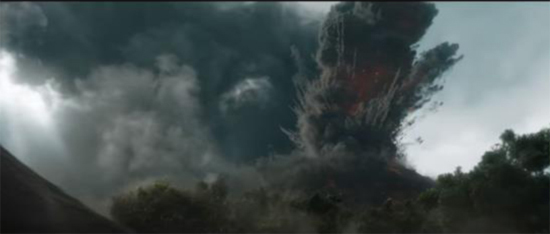New Research Helps to Predict Unpredictable Lava Flows
Scientists, including researchers from Manchester University are using the latest 4D technology to predict the behaviour of lava flows after a volcanic eruption. The results, published in the journal “Scientific Reports” help explain why some lava flows can cover many miles in just a few hours, whilst others travel much more slowly. Highlighting the hazards posed by fast-moving flows will help to save lives and could lead to better management strategies.
Predicting Lava Flows
New Technology Helping to Minimise the Threat of Lava Flows following Volcanic Eruptions
Picture credit: Universal Pictures
The research involves studying the processes that take place during crystallisation in basaltic magmas, 4D synchrotron X-ray microtomography technology is being utilised to study lava flow. It is the first time this kind of 4D scanning technology has been used for investigating crystallisation during volcanic eruptions and for simulating the behaviour of these potentially devastating natural events.
The team, led by Professor Mike Burton, (Chair of Volcanology at Manchester University), monitored crystallisation in magmas, a fundamental process that drives eruptions and controls different kinds of volcanic activity. Using this new and novel approach the team can, for the first time, watch the crystals grow in three dimensions in real-time, simulating the behaviour of lava flows once a volcano has erupted. The process is similar to scenes recently witnessed at Kilauea in Hawaii.
The professor explained:
“During volcanic eruptions small crystals grow within magma. These crystals can greatly change the way magma flows. Simply put, the more crystals there are the slower the eruption will be which also reduces the speed and distance travelled by lava flows. The fewer crystals present in the lava means the eruption will speed up, potentially becoming more powerful and devastating. Our research and this new approach open an entirely new frontier in the study of volcanic processes.”
Studying Samples from Real Volcanic Eruptions
To study the rate of crystal growth, the team set up a sample from a real eruption in a high temperature cell, before performing X-ray CAT scans whilst controlling the temperature of the magma. This allowed the researchers to visualise the formation and growth of crystals, and measure how quickly they grew.
Using this method and technology the researchers can collect hundreds of 3D images during a single experiment. This data is then used in complex, numerical models to fully characterise the behaviour of volcanic eruptions more accurately.
Lead author of the recently published paper, Dr Margherita Polacci (University of Manchester’s School of Earth and Environmental Sciences), added:
“Being able to more accurately predict the behaviour of lava flows could also allow us to help relevant safety agencies devise and develop new safety strategies and actions when dealing with eruptions in populated areas.”
Extending this Technology into Other Fields
The researchers are confident that predicting lava flows will not be the only application for this new technology. The team expect their research to have implications for mineral extraction as well as other geological processes. For the time being, any advances in the prediction models for the behaviour of lava flows would be welcomed, given the obvious benefits such tools will have to the authorities when it comes to planning evacuations and minimising the risk to life.
The scientific paper: “Crystallisation in Basaltic Magmas Revealed via in situ 4D synchrotron X-ray Microtomography” by M. Polacci, F. Arzilli, G. La Spina, N. Le Gall, B. Cai, D. Di Genova, N. T. Vo, S. Nonni, R. C. Atwood, E. W. Llewellin, P. D. Lee and M. R. Burton published in the journal Scientific Reports.
Everything Dinosaur acknowledges the help of a press release from the University of Manchester in the compilation of this article.
Visit the Everything Dinosaur website: Everything Dinosaur.







Leave A Comment